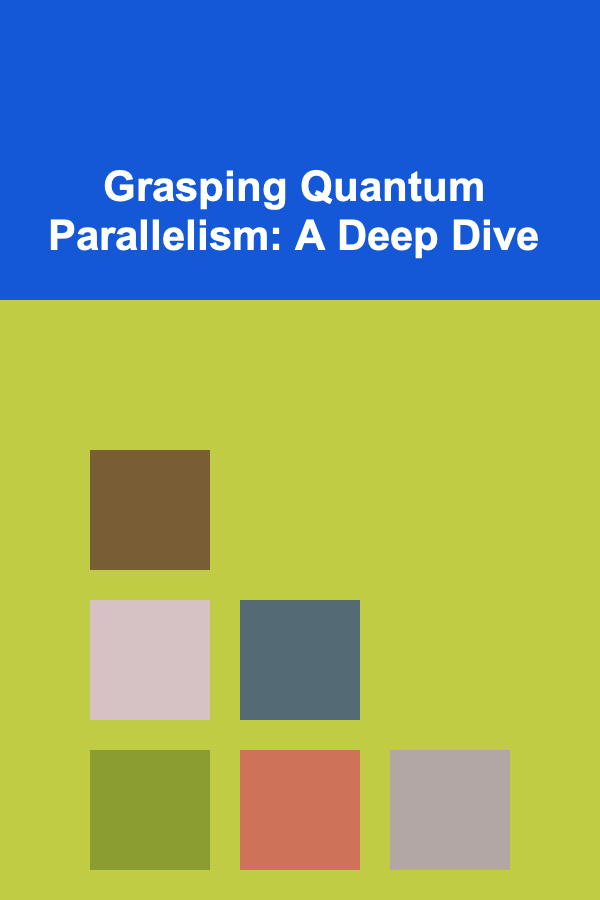
Grasping Quantum Parallelism: A Deep Dive
ebook include PDF & Audio bundle (Micro Guide)
$12.99$9.99
Limited Time Offer! Order within the next:

Quantum parallelism is a cornerstone concept in quantum computing, offering a dramatic advantage over classical computation for certain types of problems. It's the ability of a quantum computer to perform multiple computations simultaneously, leveraging the principles of superposition and entanglement. However, understanding quantum parallelism requires delving into the fundamental differences between classical and quantum systems and embracing counter-intuitive ideas. This article aims to provide a comprehensive and insightful explanation of quantum parallelism, exploring its underlying principles, practical implications, and the challenges involved in harnessing its power.
The Classical vs. Quantum Divide: A Foundation for Understanding
To truly appreciate quantum parallelism, it's crucial to understand how it deviates from classical computation. In classical computing, bits are the fundamental units of information, representing either 0 or 1. A classical computer manipulates these bits through logical gates (AND, OR, NOT, etc.) to perform computations. At any given time, each bit holds a definite value, and the computation proceeds step-by-step, processing one input at a time. Think of it like a single person meticulously working through a series of calculations, one after the other.
Quantum computing, on the other hand, introduces the concept of qubits. A qubit, unlike a bit, can exist in a superposition of states. This means it can be both 0 and 1 simultaneously. Mathematically, a qubit's state is represented as a linear combination of the basis states |0⟩ and |1⟩: α|0⟩ + β|1⟩, where α and β are complex numbers called amplitudes, and |α|^2^ + |β|^2^ = 1. The squared magnitudes of these amplitudes, |α|^2^ and |β|^2^, represent the probabilities of measuring the qubit as 0 or 1, respectively. This superposition is the key ingredient that enables quantum parallelism.
Furthermore, entanglement plays a crucial role in extending quantum parallelism across multiple qubits. Entangled qubits are linked together in such a way that their fates are intertwined, regardless of the distance separating them. When you measure the state of one entangled qubit, you instantly know the state of the other, even if they're light-years apart. This correlation allows for complex computations to be performed across multiple qubits simultaneously.
Superposition: The Engine of Parallelism
Let's dive deeper into superposition and how it powers quantum parallelism. Imagine we have a system of n qubits. Each qubit can be in a superposition of |0⟩ and |1⟩. Therefore, the system as a whole can be in a superposition of 2^n^ states. This is where the exponential scaling of quantum parallelism comes from. A 3-qubit system, for example, can be in a superposition of 2^3^ = 8 states simultaneously.
Now, consider a quantum algorithm that applies a unitary transformation (a quantum operation that preserves the norm of the state vector) to this superposition. This transformation effectively performs a computation on all 2^n^ possible inputs simultaneously. The quantum computer doesn't execute these computations sequentially; it explores them all at once due to the superposition. This is the essence of quantum parallelism: evaluating a function for multiple inputs concurrently.
Think of it this way: a classical computer is like a maze solver that explores each path one at a time. A quantum computer, leveraging superposition, is like having 2^n^ maze solvers exploring all paths simultaneously.
Example: Hadamard Gate and Superposition
The Hadamard gate (H) is a single-qubit gate that creates a superposition. When applied to a qubit initialized to |0⟩, it transforms it into an equal superposition of |0⟩ and |1⟩:
H |0⟩ = (|0⟩ + |1⟩) / √2
If we apply the Hadamard gate to each qubit in a system of n qubits initialized to |00...0⟩, we create an equal superposition of all 2^n^ possible states:
H⊗n |00...0⟩ = Σx=02n-1 |x⟩ / √2n
Where H^⊗n^ represents the Hadamard gate applied to each of the n qubits, and |x⟩ represents the binary representation of the integer x.
Quantum Algorithms: Harnessing Parallelism
While superposition allows for the simultaneous evaluation of multiple inputs, the challenge lies in extracting useful information from the resulting superposition. Directly measuring the final state collapses the superposition into a single, random outcome, losing the information gained from the parallel computations. Therefore, quantum algorithms are carefully designed to leverage interference and other quantum phenomena to amplify the desired solutions and suppress the unwanted ones.
Here are some prominent examples of quantum algorithms that effectively utilize quantum parallelism:
- Shor's Algorithm: This algorithm efficiently factors large numbers, a problem that is computationally intractable for classical computers. It leverages quantum parallelism to find the period of a function, which is then used to factor the number. The quantum Fourier transform (QFT) is a key component, and its quantum speedup stems from its ability to efficiently compute the discrete Fourier transform on a superposition of states.
- Grover's Algorithm: This algorithm provides a quadratic speedup for searching an unsorted database. Instead of checking each entry one by one, Grover's algorithm uses quantum parallelism to explore all entries simultaneously and then amplifies the amplitude of the correct entry using a process called amplitude amplification.
- Quantum Simulation: Quantum computers are particularly well-suited for simulating quantum systems, such as molecules and materials. This is because simulating these systems classically requires exponentially increasing computational resources as the size of the system grows. Quantum computers can simulate these systems more efficiently by directly exploiting the principles of quantum mechanics, leveraging quantum parallelism to explore the vast state space of the quantum system.
The Measurement Problem: A Hurdle to Overcome
As mentioned earlier, the act of measurement in quantum mechanics collapses the superposition, yielding only one outcome. This is known as the measurement problem. It poses a significant challenge in harnessing quantum parallelism. If we simply measure the final state of a quantum computation, we'll only get one answer out of the many that were computed in parallel. Therefore, quantum algorithms must be carefully designed to ensure that the desired result is amplified during the computation, so that it is more likely to be observed upon measurement.
Quantum algorithms achieve this through techniques like quantum interference. By manipulating the phases of the amplitudes in the superposition, the algorithm can cause the amplitudes corresponding to incorrect answers to cancel each other out, while the amplitudes corresponding to the correct answers add together constructively. This increases the probability of measuring the correct answer.
Think of it like a wave interference pattern. When waves are in phase, they amplify each other, creating a larger wave. When they are out of phase, they cancel each other out. Quantum algorithms use similar principles to amplify the desired solutions and suppress the unwanted ones.
Decoherence: The Enemy of Quantum Parallelism
Another major challenge in realizing the full potential of quantum parallelism is decoherence. Decoherence is the loss of quantum coherence, which essentially destroys the superposition and entanglement that are essential for quantum computation. It occurs when the quantum system interacts with its environment, causing the qubits to lose their quantum properties and behave more like classical bits.
Decoherence is a significant problem because it limits the duration for which a quantum computation can be performed. The longer the computation, the more likely it is that decoherence will occur, destroying the superposition and rendering the computation useless. Therefore, maintaining quantum coherence for a sufficiently long time is crucial for performing complex quantum computations.
Researchers are actively working on various techniques to mitigate decoherence, including:
- Improved qubit design: Developing qubits that are less susceptible to environmental noise.
- Quantum error correction: Encoding quantum information in a way that allows for the detection and correction of errors caused by decoherence.
- Topological qubits: Using qubits that are inherently resistant to decoherence due to their topological properties.
Quantum Parallelism in Practice: Building Quantum Computers
Building practical quantum computers that can effectively harness quantum parallelism is a monumental engineering challenge. Several different physical platforms are being explored for building qubits, each with its own advantages and disadvantages. Some of the most promising platforms include:
- Superconducting qubits: These qubits are based on superconducting circuits and are currently the most mature technology for building quantum computers. Companies like Google, IBM, and Rigetti are actively developing superconducting quantum computers.
- Trapped ion qubits: These qubits are based on individual ions that are trapped and controlled using electromagnetic fields. Trapped ion qubits are known for their high fidelity and long coherence times. Companies like IonQ are focused on developing trapped ion quantum computers.
- Photonic qubits: These qubits are based on photons, which are particles of light. Photonic qubits are well-suited for transmitting quantum information over long distances.
- Neutral atom qubits: These qubits are based on neutral atoms that are trapped and controlled using lasers. Neutral atom qubits offer a good balance between coherence time and scalability.
Each of these platforms faces unique challenges in terms of scalability, coherence, and control. However, significant progress is being made in all these areas, and the field of quantum computing is rapidly advancing.
Beyond Computation: Quantum Parallelism in Other Domains
While quantum parallelism is primarily associated with quantum computation, its underlying principles have implications for other domains as well:
- Quantum Machine Learning: Quantum parallelism can be used to accelerate machine learning algorithms. For example, quantum algorithms can speed up the training of neural networks and the clustering of data.
- Quantum Cryptography: Quantum parallelism, combined with other quantum phenomena like entanglement, enables secure communication protocols that are impossible to achieve classically.
- Quantum Sensing: Quantum sensors can leverage superposition and entanglement to achieve unprecedented sensitivity in measuring physical quantities like magnetic fields and gravitational waves.
Conclusion: Embracing the Quantum Revolution
Quantum parallelism is a powerful and revolutionary concept that promises to transform computation and other fields. While it presents significant challenges, including the measurement problem and decoherence, the potential rewards are immense. By understanding the underlying principles of superposition, entanglement, and quantum interference, we can begin to unlock the full potential of quantum parallelism and build a future where quantum computers can solve problems that are currently intractable for even the most powerful classical computers.
The journey into quantum computing is a journey into a realm of counter-intuitive phenomena and profound possibilities. Grasping quantum parallelism requires a shift in perspective, embracing the idea that a single quantum system can exist in multiple states simultaneously, performing computations on all those states in parallel. As quantum technology continues to advance, the ability to understand and harness quantum parallelism will be crucial for researchers, engineers, and anyone seeking to participate in the quantum revolution.

How to Build a Reputation as a Reliable Data Entry Worker
Read More
How to Incorporate Festive Fabrics and Textures into Your Home Decor
Read More
How to Organize Space-Saving Toy Storage Ideas for Family Spaces
Read More
How to Sort Linen and Towels in Your Closet System
Read More
How to Use Doorbell Cameras to Improve Your Home Security
Read More
Caring for Your Cast Iron Bakeware: A Comprehensive Guide
Read MoreOther Products

How to Build a Reputation as a Reliable Data Entry Worker
Read More
How to Incorporate Festive Fabrics and Textures into Your Home Decor
Read More
How to Organize Space-Saving Toy Storage Ideas for Family Spaces
Read More
How to Sort Linen and Towels in Your Closet System
Read More
How to Use Doorbell Cameras to Improve Your Home Security
Read More